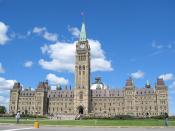"What we're seeing now is demographics which are really driven more and more by immigration."
-Dough Norris, director general of Statistics Canada.
For the first time in history, Canada is facing a population decline beginning in 2010. Population decline this is happening in a decade where both demographic and economic growth is imperative. From 1996-2001, Canada's population had a 4% (1.2 million) increase in population, making it the lowest 5-year growth rate census taken in Canadian history. Also, during the census it was concluded that the birth rate in Canada is also declining at an alarming rate, (See Graph 1). For the first time in 100 years the birth rate fell below that of the United States. The census showed that about 80% of the 1.2 million new Canadians in the 5-year span were a result of immigration. People are now saying that immigration is Canada's only chance to fill its demographic and economic needs.
To keep the population of Canada stable, a major influx of immigration is required each year. Statistics show that Canada's fertility rate is extremely low, at 1.5 children per family. In order to maintain a stable population, the fertility rate should be around 2.1. On top of this, Canada will be facing a major labour shortage within 5-10 years, because there will not be enough skilled workers to fill the job demands. A policy analyst, speaks of another downfall for Canada's economy when she says,
"This is the generation of people whose incomes and wealth will be required by that proportionately larger number of Baby Boomers once they've retired." .
Another huge upcoming economic setback in Canada is the aging baby-boomer population. By 2035, the percentage of Canadians who are 65+ will double from 12% to 25%, (See Graph 2). By that time, there will...


